
Henry Quelch was one of the first Marxists and founders of the social democratic movement in Great Britain. He was a socialist activist, journalist and trade unionist. His brother, Lorenzo "Len" Quelch, was also a socialist activist, while his son, Tom Quelch, achieved note as a prominent communist activist.

Sir John Murray was a pioneering Canadian-born British oceanographer, marine biologist and limnologist. He is considered to be the father of modern oceanography.
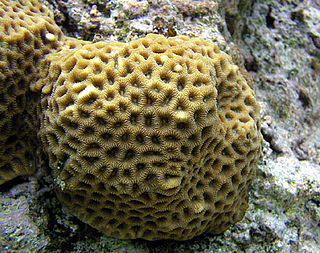
Brain coral is a common name given to various corals in the families Mussidae and Merulinidae, so called due to their generally spheroid shape and grooved surface which resembles a brain. Each head of coral is formed by a colony of genetically identical polyps which secrete a hard skeleton of calcium carbonate; this makes them important coral reef builders like other stony corals in the order Scleractinia. Brain corals are found in shallow warm water coral reefs in all the world's oceans. They are part of the phylum Cnidaria, in a class called Anthozoa or "flower animals". The lifespan of the largest brain corals is 900 years. Colonies can grow as large as 1.8 m (6 ft) or more in height.

Helicolenus is a genus of marine ray-finned fishes belonging to the family Scorpaenidae where they are classified within the subfamily Sebastinae, the rockfishes. The species in this genus are found in the Indian, Atlantic and Pacific oceans.

Justice was the weekly newspaper of the Social Democratic Federation (SDF) in the United Kingdom.
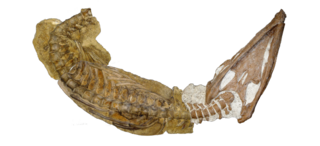
Brachauchenius is an extinct genus of pliosaurid that lived in North America and Morocco during the Late Cretaceous.

Eledone is a genus of octopuses forming the only genus in the family Eledonidae. It is mainly distributed in the northern and southern Atlantic Ocean, with one species, E. palari, described from the southwestern Pacific Ocean and eastern Indian Ocean in waters around Indonesia and Australia and another, E. microsicya, from the western Indian Ocean. One species, E. thysanophora, is now regarded as a synonym of the brush-tipped octopus.
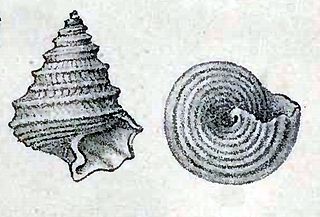
Seguenziidae is a family of very small deepwater sea snails, marine gastropod mollusks in the superfamily Seguenzioidea.

Goniopora, commonly referred to as flowerpot coral or daisy coral, is a genus of colonial stony coral found in lagoons and turbid water conditions. Goniopora have numerous daisy-like polyps that extend outward from the base, each tipped with 24 stinging tentacles which surrounds a mouth.

Metacrinus is a genus of stalked crinoids in the family Isselicrinidae. Members of this genus live on hard surfaces in deeper parts of the ocean. The genus has extant species and is also represented in the fossil record. Members of the genus grow to a maximum height of 60 centimetres (24 in) and are found in the eastern Pacific Ocean from Japan to Australia.

Stylaster is a genus of hydroids in the family Stylasteridae.
Acropora speciosa is a species of acroporid coral found in the Red Sea, the Gulf of Aden, the southwest and northern Indian Ocean, the central Indo-Pacific, Southeast Asia, Japan, the East China Sea, eastern Australia and the oceanic west and central Pacific Ocean. It occurs in shallow reefs at depths of 2 to 25 metres.
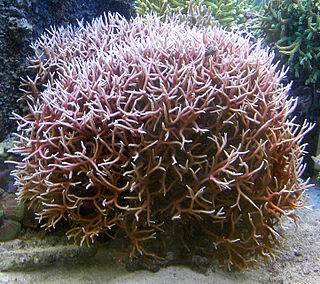
Seriatopora is a genus of colonial stony corals in the family Pocilloporidae. They are commonly known as needle corals, birdsnest corals or finger corals. They are native to the Red Sea, the Indo-Pacific region and some parts of the Central Pacific Ocean.
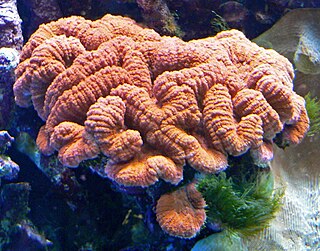
Lobophylliidae is a family of large polyp stony corals. The family was created in 2009 after a revision of the "robust" families of Faviidae, Merulinidae, Mussidae and Pectiniidae, which had been shown to be polyphyletic. The family Lobophylliidae was formed out of the Indo-Pacific species that had traditionally been included in Mussidae, and some of the species which had previously formed Pectiniidae, the remaining species from Pectiniidae having been merged into Merulinidae. The type genus is Lobophyllia.
Seriatopora aculeata is a species of colonial stony coral in the family Pocilloporidae. It forms a bushy clump. It is native to the Central Indo-Pacific and the Oceanic West Pacific. Its range includes the Philippines, the Great Barrier Reef, Fiji, Indonesia, the Coral Sea, southern Madagascar and Vanuatu. It grows in shallow reef environments, at depths down to about 40 metres (130 ft). It is an uncommon species and subject to coral diseases and bleaching. The International Union for Conservation of Nature has assessed the conservation status of this species as being "vulnerable".
Seriatopora stellata is a species of colonial stony coral in the family Pocilloporidae. It is native to the western Indo-Pacific region, its range extending from the central Indian Ocean to the central Indo-Pacific, northwestern Australia, Indonesia, Japan, the south China Sea and the oceanic island groups in the West Pacific. It grows in shallow water on sheltered reef slopes at depths down to about 20 metres (66 ft). It is a widespread but uncommon species and the International Union for Conservation of Nature has assessed its conservation status as being "near threatened".

Goniopora tenuidens is a species of colonial stony coral in the family Poritidae. It occurs in shallow water in the tropical Indo-Pacific region. The International Union for Conservation of Nature has assessed its conservation status as being of "least concern".
Moseleya is a genus of cnidarians belonging to the family Lobophylliidae.

Zygophylax is a genus of cnidarians belonging to the family Zygophylacidae.

Physogyra is a genus of cnidarians belonging to the family Plerogyridae.
















